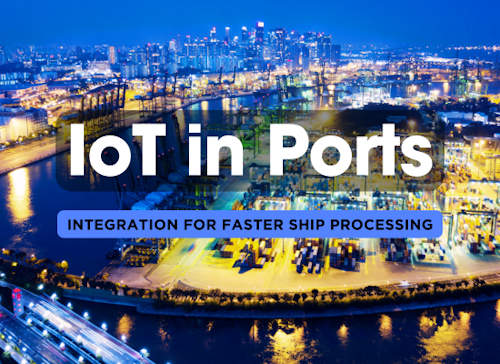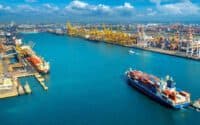Integrating IoT in Ports: Real-Time Data for Faster Ship Processing

As global trade continues to expand, the pressure on port operations to manage increasing volumes of cargo efficiently has never been greater. Integrating the Internet of Things (IoT) into port operations offers a transformative solution, providing real-time data that can streamline processes, enhance safety, and reduce operational costs. From tracking cargo in real-time to optimizing equipment usage and managing environmental conditions, IoT technology is unlocking new levels of efficiency in ports around the world. This article delves into the key IoT applications that are revolutionizing port operations, providing a detailed look at how these technologies are shaping the future of maritime logistics.
| ShipUniverse: Key IoT Applications in Ports | |||
|---|---|---|---|
| IoT Application | Operational Area | Key Benefits | Challenges |
| Cargo Tracking | Container Management |
|
|
| Equipment Monitoring | Maintenance and Operations |
|
|
| Traffic Management | Ship and Vehicle Traffic |
|
|
| Environmental Monitoring | Environmental Compliance |
|
|
| Automated Gate Operations | Entry and Exit Points |
|
|
| Remote Crane Operations | Cargo Handling |
|
|
| Energy Management Systems | Port Operations |
|
|
| Supply Chain Visibility | Logistics and Distribution |
|
|
Benefits of IoT Integration
Integrating IoT into port operations offers numerous advantages that can significantly enhance the efficiency, safety, and sustainability of port activities. Here’s a detailed breakdown of these benefits:
Efficiency Improvements
- Faster Cargo Processing:
- IoT enables real-time tracking of containers and cargo, allowing for more efficient coordination of loading and unloading processes.
- Automated systems can allocate resources dynamically, reducing delays and bottlenecks in cargo handling.
- Optimized Equipment Usage:
- IoT sensors monitor the status and availability of port equipment, such as cranes and trucks, ensuring they are used optimally and minimizing idle time.
- Real-time data allows for better scheduling of equipment, reducing the time ships spend in port.
Cost Reductions
- Predictive Maintenance:
- IoT devices continuously monitor the condition of port machinery, predicting when maintenance is needed before a breakdown occurs.
- By preventing unexpected equipment failures, ports can reduce costly downtime and avoid expensive emergency repairs.
- Reduced Operational Costs:
- Automated systems decrease the reliance on manual labor, lowering overall labor costs while improving operational speed and accuracy.
- Energy management systems, powered by IoT, optimize energy consumption, leading to significant cost savings on utilities.
Safety Enhancements
- Real-Time Monitoring of Hazardous Conditions:
- IoT sensors can detect and alert workers to hazardous conditions, such as gas leaks, fires, or equipment malfunctions, in real-time.
- Wearable IoT devices can track worker health and safety, providing immediate alerts if a worker is in danger, ensuring timely interventions.
- Enhanced Security:
- IoT-based surveillance and monitoring systems provide comprehensive coverage of port areas, improving security against theft, vandalism, and unauthorized access.
Environmental Impact
- Reduction in Emissions:
- IoT enables more efficient operations, reducing the amount of time ships spend idling in port, leading to lower greenhouse gas emissions.
- Energy management systems optimize the use of electricity and fuel, contributing to reduced carbon footprints.
- Optimized Resource Use:
- IoT systems help in optimizing the use of water, energy, and other resources, ensuring that port operations are as sustainable as possible.
- Real-time environmental monitoring allows ports to maintain compliance with environmental regulations, preventing fines and promoting sustainable practices.
| ShipUniverse: Cost-Benefit Analysis of IoT Integration | |||
|---|---|---|---|
| IoT Implementation Cost | Expected Efficiency Gains | Cost Savings | Payback Period |
| Initial Hardware and Software Investment |
|
|
|
| Ongoing Maintenance and Support Costs |
|
|
|
| Scalability and Upgrade Costs |
|
|
|
| Compliance and Regulatory Costs |
|
|
|
The integration of IoT into port operations is not just a technological upgrade—it's a strategic necessity in an increasingly competitive and fast-paced maritime industry. IoT's ability to provide real-time data and enable intelligent automation across port operations fundamentally transforms how ships are processed. By reducing bottlenecks, optimizing equipment usage, and streamlining documentation, IoT ensures that ports can keep pace with the growing demands of global trade.
As ports around the world continue to adopt IoT technologies, those that do so effectively will set new standards for efficiency, speed, and reliability in ship processing. The advantages are clear: faster turnaround times, lower operational costs, and enhanced safety—all of which contribute to a more robust and resilient supply chain. In an era where time is money, especially in the maritime sector, IoT is the key to unlocking faster, smarter, and more efficient port operations that will define the future of global shipping.
Additional References
U.S. Department of Transportation - Smart Ports and IoT
- Full URL: https://www.transportation.gov/research-innovation/smart-ports-and-iot
- Description: This page from the U.S. Department of Transportation discusses the integration of IoT in smart port initiatives, exploring how these technologies are enhancing port efficiency and sustainability.
European Commission - Digital Transport and Logistics Forum (DTLF)
- Full URL: https://ec.europa.eu/transport/modes/maritime/digital_transport_logistics_forum_en
- Description: The European Commission's page on the Digital Transport and Logistics Forum outlines the role of digitalization, including IoT, in modernizing port operations across Europe.
National Institute of Standards and Technology (NIST) - IoT in Smart Infrastructure
- Full URL: https://www.nist.gov/programs-projects/internet-things-iot-smart-infrastructure
- Description: NIST provides an overview of how IoT is being applied in smart infrastructure, including ports, to improve operational efficiency and enhance safety standards.
United Nations Conference on Trade and Development (UNCTAD) - Port Management Series
- Full URL: https://unctad.org/webflyer/port-management-series
- Description: UNCTAD’s Port Management Series discusses various aspects of port management, including the adoption of IoT technologies, to improve the efficiency and competitiveness of ports worldwide.

Do you have a Maritime Product or Service that may be of interest to Shipowners? Tell us about it here!
Do you have feedback or insights? Please reach out to editor @ shipuniverse.com



